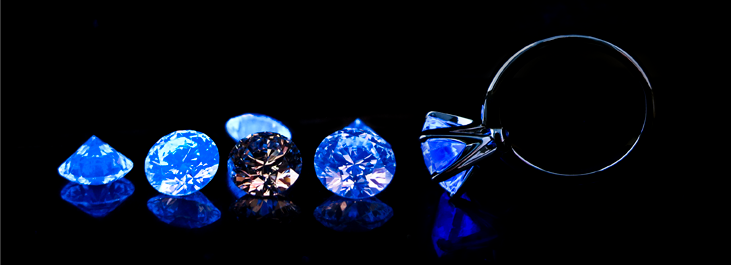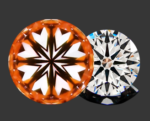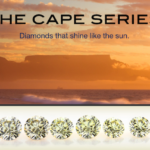All About Diamond Fluorescence
About a third of all natural diamonds have what is called diamond fluorescence. Diamonds of this group temporarily luminesce when exposed to invisible ultraviolet (UV) light. The visible light emitted can range in different colors including blue (most common), white, yellow, orange, and red (less common).
The strength of the visible light emitted is also measured in a range commonly described by GIA as none, faint, medium, strong and very strong. AGSL fluorescence grading includes negligible (none and faint are combined as they have no visual impact), medium, strong and very strong.

Blue Fluorescent Diamonds – Pros and Cons
Blue fluorescent diamonds pose no aesthetic disadvantage to non fluorescent diamonds. However, in some rare cases, strong to very strong blue fluorescence may display a ‘milky white’ or cloudy looking appearance when exposed to UV rays (natural daylight for example). In these diamonds, they loose their transparency and are said to be hazy, milky, or oily in appearance.
Conversely, in cases where there is medium or stronger blue fluorescence in near-colorless (G, H, I or J) or cape diamonds one can see quite a dramatic change which temporarily makes the diamond appear “whiter” after UV exposure. Blue and yellow are complimentary colors and nullify or cancel out each other. Thus, many have said that blue fluorescent diamonds are desirable in both cost savings as well as brighter diamond appearance.
In fact, some boutique diamond retailers have commercialized this diamond characteristic as a unique selling point. Retailers like Brian Gavin offer super ideal round, cushion and princess diamonds that fluoresce with medium to very strong blue fluorescence. Brian’s Signature Blue Diamonds are a favorite among many due to the lower prices and typically larger carat weight that can be offered by the compromise of the blue fluorescence.
Colorless Blue Fluorescent Diamonds
Colorless diamonds (D, E, and F) receive no visual benefit from having blue fluorescence in any strength range. However, conversely if these colorless diamonds have no milky or cloudy appearance after being exposed to UV rays then it can also be said that these colorless diamonds also show no negative effect either. Nevertheless, these diamonds are penalized in the diamond wholesale market and are devalued.
The reason why these colorless diamonds are priced at a discount is due to the inaccuracy in diamond grading. Gem labs need to grade each diamond individually under specific lighting conditions. If the labs use bulbs that emit UV then the diamond will also fluoresce under these conditions. This will obviously skew the results and thus colorless diamonds are discounted in the wholesale market with strong to very strong being more heavily penalized.
In conclusion, it can be seen that blue fluorescence in diamonds is a natural characteristic and quite common. The characteristic can be seen as both a pro and a con depending on specific circumstances.
For more information on the grading of blue fluorescent diamonds please visit: Diamond Fluorescence – Good or Bad?
For more information on the detailed history of Blue White diamonds, please visit: Blue White Diamonds
As always, if you are in need of some help or advice in purchasing a diamond online, please don’t hesitate to contact me! I look forward to working with you!
Happy Diamond Buying!
ODBA Recommends









